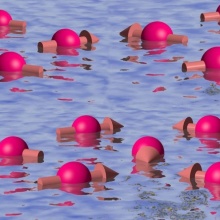Location: Faculty room 2.136
Time: Block Seminar
Wednesday 22. May 2024
Thursday 23. May 2024
Program
Campus: 049500552S Advanced Seminar 5: Magnetism: from fundamental quantum phenomena, advanced methods to widespread applications
Submission of written summary (8-10 Pages) by 30. June 2024
Regeln Physikalisches Hauptseminar SoSe2024
Guidelines Advanced Seminar SoSe24
Please use the following link to complete a survey about the course:
https://qe.evaluation.uni-stuttgart.de/#/instructor-portal
Magnetism:
From fundamental quantum phenomena, advanced methods to widespread applications
1. First and second order phase transition
- Definition and properties from thermodynamics
- Landau theory of phase transition
- Critical behavior in second order phase transition
- Examples in magnetic material and properties
- Examples of first and second order phase transitions in condensed matter
References:
Theory of First order phase transitions by K. Binder
First order magneto-structural phase transition and associated multi-functional properties in magnetic solids, https://iopscience.iop.org/article/10.1088/0953-8984/25/18/183201/meta
Introduction to Phase transitions and critical phenomena by H. E. Stanley
2. Spin ice, spin glass and cluster glass compounds
- What is magnetic monopole? Does it exist in the universe?
- Electro-magnetic properties
- Do we see them in condensed matter/magnetic materials (spin ice compound)
- Residual entropy in spin ice compounds
- Ingredients of glass formation in condensed matter
- What is the difference between spin glass and cluster glass state
- Examples of spin glass and cluster glass states in real materials
- How to identify a glassy system and distinguish between spin glass and cluster glass?
References:
Magnetic monopoles in spin ice by C. Castelnovo et al, https://www.nature.com/articles/nature06433
Measurement of the charge and current of magnetic monopoles in spin ice by S. T. Bramwel, https://www.nature.com/articles/nature08500
Spin glasses: An experimental Introduction by J. A. Mydosh
Spin glasses: redux: an updated experimental survey
https://iopscience.iop.org/article/10.1088/0034-4885/78/5/052501
and references therein
3. Magnetic frustration and Quantum spin liquid
- What is the meaning of Geometrical frustration
- What are the preliminary experimental signatures of a Quantum spin liquid state?
- Examples observed in solid state physics and how they are detected in experiment?
References:
Savary, L.; Balents, L. "Quantum spin liquids: a review". Reports on Progress in Physics. 80, 016502 (2017).
Yi Zhou, Kazushi Kanoda, and Tai-Kai Ng, Quantum spin liquid states, Rev. Mod. Phys. 89, 025003 (2017)
4. Magnetic Skyrmions and Propagating spin excitations (Spin waves, magnons, Spinons)
- What is magnetic Skyrmions?
- Some examples where it is observed?
- Application in Spintronic devices
- What are Spin waves, magnon and Spinons?
- Where are they observed?
- Properties
- How these excitations can be probed in real materials?
References:
Magnetic Skyrmions: Basic properties and potential applications by S. Li et al
https://onlinelibrary.wiley.com/doi/full/10.1002/idm2.12072
Physical foundation and basic properties of magnetic skyrmions, by A. N. Bogdanov, Nature reviews (2020)
https://www.nature.com/articles/s42254-020-0203-7
https://www.nature.com/articles/nphys3347
https://iopscience.iop.org/article/10.1088/0034-4885/29/1/307
https://www.google.de/books/edition/Spin_Waves/ehN6-ubvKwoC?hl=de&gbpv=1&dq=spin+waves&printsec=frontcover
5. Quantum magnetism using ultra-cold atoms
- What is ultra-cold atom?
- How we can manipulate them to mimic a real system?
- Benefits of using them. How to different structures of ultra-cold atoms can be used to study fundamentals of condensed matter physics?
- Any limitations?
References:
https://physicsworld.com/a/quantum-magnetism-simulated-using-ultracold-fermions/
https://www.nature.com/articles/nphys2259
https://physics.aps.org/articles/v14/159
6. Optically induced magnetization switching
- Femtosecond optical pulse, how to produce ultra-fast laser pulses
- How it can be used to manipulate a magnetic state? What is Optical switching of a magnetic state?
- Application in spintronic devices
References:
https://www.nature.com/articles/s41563-023-01499-z
https://www.nature.com/articles/s41563-023-01554-9
https://doi.org/10.1063/1.4958846
https://doi.org/10.1103/RevModPhys.82.2731
7. Neutron scattering
- Why do we use neutrons for magnetic materials?
- How do diffraction methods work?
- What are elastic and inelastic neutron scatterings and how they are useful to understand a magnetic system?
- Examples of applications in real materials
References:
Neutron Diffraction: Principles, Instrumentation and application
https://www.researchgate.net/publication/321586078_Neutron_diffraction_Principles_Instrumentation_and_application
Neutron Diffraction by Paramagnetic and Antiferromagnetic Substances by C. G. Shull et al (1951)
https://journals.aps.org/pr/abstract/10.1103/PhysRev.83.333
Application of neutron powder diffraction by Eric. H. Kisi, Oxford series
8. Muon spin rotation
- Why do we use muons?
- How to produce them?
- How to use muons to probe magnetic state?
References:
Muon spin spectroscopy, by A. D. Hiller (review article), https://www.nature.com/articles/s43586-021-00089-0
Blundell, S., De Renzi, R., Lancaster, T. & Pratt, F. Introduction to Muon Spectroscopy(Oxford Univ. Press, 2021).
9. Terahertz spectroscopy
- What is Terahertz spectroscopy?
- How to produce Terahertz radiation?
- Energy scales involved?
- Some examples how it can be used to probe a magnetic material?
References:
Terahertz spectroscopy: Principles and applications by Susan L. Dexhemeir
Review of recent progress on THz spectroscopy of quantum materials: Superconductors, magnetic and topological materials, by Arnab Bera et al, https://link.springer.com/article/10.1140/epjs/s11734-021-00216-8
and references therein
10. Magnetic resonance and its application to Imaging in medical science
- Basic principle of electron spin resonance techniques
- What do you mean by Quality factor of a cavity?
- Different types of electron spin resonance spectroscopy?
- How these techniques can be used to study materials?
- Application in various fields
References:
Electron spin resonance, by Charles P. Poole
Electron spin resonance, by Abragam, B. Bleaney
11. Nitrogen Vacancy (NV) centers in Diamond for magnetic sensing
- What are NV centers?
- How to create NV centers?
- Application in magnetometry
References:
Creation of NV centers by Chemical vapor deposition….. by T. Luo et al, New Journal of Physics (2022), https://iopscience.iop.org/article/10.1088/1367-2630/ac58b6
Nitrogen-vacancy centers: Physics and application, https://link.springer.com/article/10.1557/mrs.2013.18
12. Magnetic memory devices
- Volatile and non-volatile memory
- Memory devices
- Race track memory device
References:
Magnetic memory: Fundamentals and technology by D. D. Tang and Y. J. Lee, Cambridge university press.
Magnetoresistive random access memory: Present and Future by S. Ikegawa et al, https://ieeexplore.ieee.org/document/8976130
13. Magnetic levitation
- Superconductivity: basic properties
- Why it levitates?
- How and where it is used?
References:
Superconductivity: A very short introduction by Stephen Blundell
Current state of magnetic levitation and its applications in polymers: A review
https://www.sciencedirect.com/science/article/abs/pii/S0925400521001015
M. Hermansen et al., “Magnetic levitation by rotation,” Phys. Rev. Appl. 20, 044036 (2023).
14. Magnetism of Earth (Geomagnetism) and its importance on human life
- Source of Earth magnetism
- Strength of Earth’s magnetic field
- Effect on Human being and on life in general
References:
Introduction to Geomagnetism by United state geometrical survey
https://www.usgs.gov/programs/geomagnetism
https://www.nature.com/subjects/geomagnetism

Sudip Pal
Dr.Electron Spin Resonance


